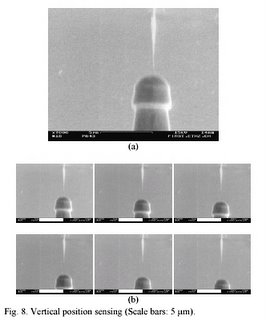hee hee!
so, my research is about studying defects in photonic crystals. a photonic crystal (thank you, britney) is a synthetic material that is made of a periodic lattice of some kind of material. for example, one type of material that we use a lot is a lattice made of silica (glass) spheres, with air gaps between them, and arranged in a hexagonally close-packed or face-centered-cubic structure. this material is called a synthetic opal, because it has the same structure as precious opals found in nature.
so what makes it "photonic"? well, if you make the spheres approximately the same size as the wavelength of some light, then that light won't propagate through the lattice along certain crystal planes. this is called a photonic bandgap and is analogous to the electronic bandgap in semiconductors that makes them.. well, semiconductors. this optical bandgap can be used to confine light inside a structure, which can be very useful in the design of integrated optical circuits.
the point of all this is that the technology could have some seriously kick-ass uses, like optical computers that run at terahertz clock speeds. have you noticed that for the last few years, processor speeds have largely plateaued at around 3-3.5 GHz? for a while there, it seemed like every six months intel would release a new chip with a faster clock - processor manufacturers were racing to push their clock speeds faster and faster. not so much anymore - they are running up against some pretty fundamental limitations of semiconductor technology. most people think it's unlikely that anyone will be able to make an electronic processor that runs faster than 10 GHz.
one reason is that as you crank up the clock speed, the processor runs hotter due to resistive losses in the circuits. so intel and others have compensated by adding ever-larger heat sinks and fans, but those are only a stopgap solution. another problem is size - as the circuits get smaller, the current-carrying paths get closer together. so close, in fact, that the electrons which carry the bits actually tunnel across the gaps and into places they're not supposed to be. a processor that works on light pulses instead of electrical pulses doesn't face these technological limitations (though there are plenty of limitations imposed by optical circuitry!)
so, anyway. that's the why - here is the how. we are going to use a nanomanipulator - sort of like a MEMS device, with piezoelectric actuators, all crammed inside an electron microscope - to modify the structure of a photonic crystal. we should be able to make a waveguide - like a current-carrying path - in order to guide light through the crystal and around corners, or introduce point defects that will act as small optical cavities. if we can get the defects right, we'll have succeeded in not just slowing light down, but stopping it entirely and localizing it in one spot. this nanomanipulator is being built in the group of sun yu, who is one of my supervisors on the project.
 so, i was reading one of the papers he sent me, which is about using a probe attached to the end of one of these nanomanipulators to measure position in an array of carbon nanotubes. here is a picture of the probe. when i saw it, i burst out laughing.. i have no idea who designed it or what possibly could have been on their mind, but who says science ain't sexy? i just might have to submit this to maxim's unintentional porn department, coz it's perfect. anyway, next time, i'll post some more detailed stuff about what i'm doing in the lab.
so, i was reading one of the papers he sent me, which is about using a probe attached to the end of one of these nanomanipulators to measure position in an array of carbon nanotubes. here is a picture of the probe. when i saw it, i burst out laughing.. i have no idea who designed it or what possibly could have been on their mind, but who says science ain't sexy? i just might have to submit this to maxim's unintentional porn department, coz it's perfect. anyway, next time, i'll post some more detailed stuff about what i'm doing in the lab. i booked a flight to france today - going to visit andy and adeline in poitiers from the 17th of february to the 27th. i haven't seen andy in like 5 years and i'll be meeting adeline, who is no longer just his girlfriend, but his wife. and their dog, marvin or chester or something. surreal, if you know andy.
ok, this post is now stupid-long.. so i'll stop. bye!



2 Comments:
PENIS
wow. that's just so wrong.
1:47 AM
i figured out what's going on here. it was probably a sharp cone-like tip that normally has a voltage put across it, and it got too close to the ground plane. current flow + small cross-sectional area = melted tip. so the tip probably melted and then cooled into a little ball at the end of the cone.
i know because i've been making these little metal weeners lately.
4:12 AM
Post a Comment
<< Home